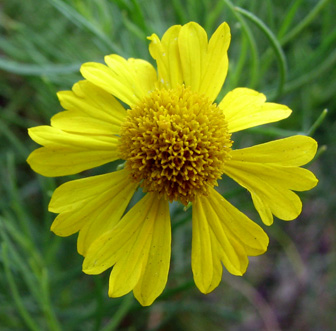The Plant w/Flowers

The Flower

(From zoology-quest.blogspot)
Description
"General: Perennial herbs, 10-35 cm tall, from a branching woody caudex and stout taproot; stems mostly 5-20 per plant, erect, slender, branched above, usually green throughout, rarely tinged with purple-red at the base; herbage glabrous to pubescent, with long soft hairs tufted in the axils of persistent leaf bases. Leaves: Basal leaves sometimes persistent until flowering; stem leaves alternate, abundant; blades narrowly linear and/or lobed, 2-15 cm long, glabrous to sparsely pubescent, gland- dotted; lobes, if present, 3-7 per leaf, linear-filiform, 1-2 mm wide. Flowers: Flower heads yellow and radiate, arranged in panicles of up to 12 flower heads; peduncles sometimes tomentose near the apex; involucres hemispheric to broadly campanulate, 12-17 mm long and 20-25 mm wide, the bracts (phyllaries) in 2 series, these nearly equal; the outer series of phyllaries united at the base; the inner series of phyllaries not united at the base, equalling or surpassing the outer series in height; ray flowers 7-14 per flower head, the laminae (ray petals) 7-23 mm long, yellow-orange to orange, the tips 3- or 4- lobed; disc flowers 25-75 or more per flower head, yellow. Fruits: Achenes narrowly obpyramidal, 2-4 mm long, covered with long soft hairs; topped with a pappus of 5 obovate, bristle-like scales, these 2 mm long." (SEINet)
Ethnobotanical Uses
Medical:
"Navajo, Ramah Ceremonial Medicine Plant used as a ceremonial emetic. Dermatological Aid Decoction of plant taken and used as lotion for red ant bites. Emetic Plant used as a ceremonial emetic. Poison Toxic to livestock, especially sheep." (Moerman 272)
Internet Links